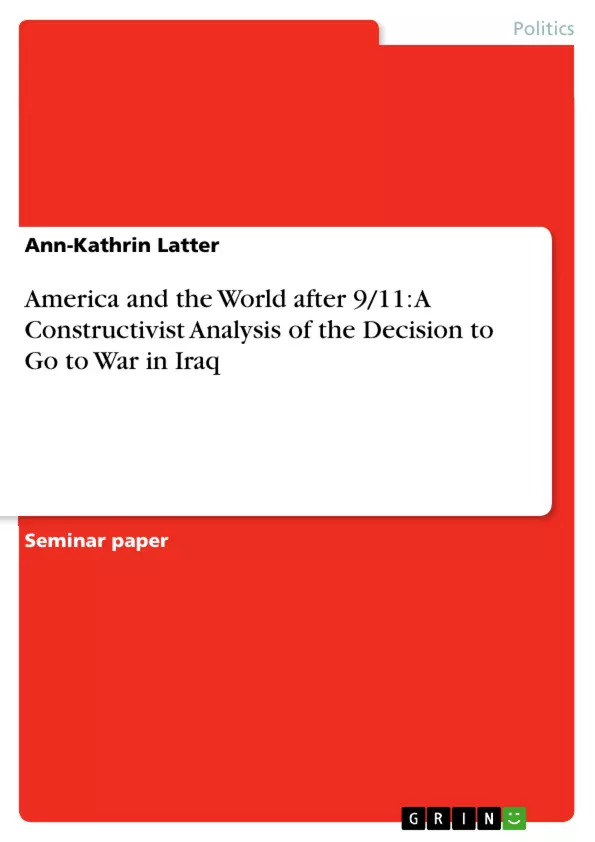This paper will look at the Iraq War, the most important operation in the Global War on Terror, under the “magnifying glass” of constructivism: the invasion of Iraq was a protracted armed conflict that escaped international standards of war-making. Why should the US risk regional stability through a belated intervention? Why should they incur the enormous humanitarian, economic, and military costs connected with a preventive war that lacked legitimacy under international law and, thus, was very likely to damage transatlantic relations? By scrutinising the Bush Administration’s rationale for war and examining a variety of possible objectives that are based on constructivist concepts, I will try to make sense of this war which remained unexplainable to many other international relations (IR) theories.
In a first step, I will give a brief introduction to Constructivist theory focusing on the three principal aspects of state identities and interests, international structure, and conditions of cooperation and conflict. Secondly, I will address the issue of America’s threat perceptions and enemy images in order to explain how inherited values and attitudes shaped the Bush Administration’s assessment of the incident. Following a description of the US rationale for war, I will focus on the theme of international normative frameworks so as to explain why they imposed their decision against the serious concerns of the UN community of states. In this context, an important role will be played by the substantial unilateral freedom of action gained by their hegemonic position in the international system. Finally, I will return to the point of US identity in order to specify that the invasion of Iraq might have made little sense from a rational point of view because it harmed European-American relations in the long term and aggravated international tensions, but that it nevertheless conformed to the imperialist ambitions of US exceptionalism and their historically defined claim to leadership.
Inhaltsverzeichnis (Table of Contents)
- Introduction
- The Theory of Constructivism
- State identities and interests
- International structures
- Conditions for cooperation and conflict
- Iraq War: American foreign policy
- Threat perceptions and the concept of offensive self defense
- International structures and normative frameworks
- US identity and hegemonic power
- Conclusion
Zielsetzung und Themenschwerpunkte (Objectives and Key Themes)
This paper aims to provide a constructivist analysis of the decision to go to war in Iraq after 9/11, focusing on the US's threat perceptions, international structures, and its role as a hegemonic power.
- The role of constructed identities and interests in shaping state behavior
- The influence of international norms and frameworks on state decision-making
- The significance of hegemonic power in shaping international relations
- The impact of 9/11 on US foreign policy and its threat perceptions
- The legitimacy of the Iraq War in light of international law and normative frameworks
Zusammenfassung der Kapitel (Chapter Summaries)
- Introduction: This chapter introduces the topic of the Iraq War and its significance in the context of 9/11. It argues that the war was a departure from international standards and presents the constructivist framework as a lens for understanding the decision to go to war.
- The Theory of Constructivism: This chapter provides an overview of the constructivist theory, emphasizing the role of ideas, identities, and social interactions in shaping state behavior. It explores how states develop their identities and interests through socialization and the influence of international norms.
- Iraq War: American foreign policy: This chapter examines the US's threat perceptions and enemy images in the aftermath of 9/11, highlighting how these perceptions influenced the decision to go to war in Iraq. It discusses the role of international structures and normative frameworks in shaping US policy and the impact of US hegemonic power on its actions.
Schlüsselwörter (Keywords)
Key concepts and themes explored in this paper include constructivism, state identity, international norms, hegemonic power, threat perception, 9/11, Iraq War, US foreign policy, and international security.
- Arbeit zitieren
- Ann-Kathrin Latter (Autor:in), 2015, America and the World after 9/11: A Constructivist Analysis of the Decision to Go to War in Iraq, München, GRIN Verlag, https://www.grin.com/document/354499



